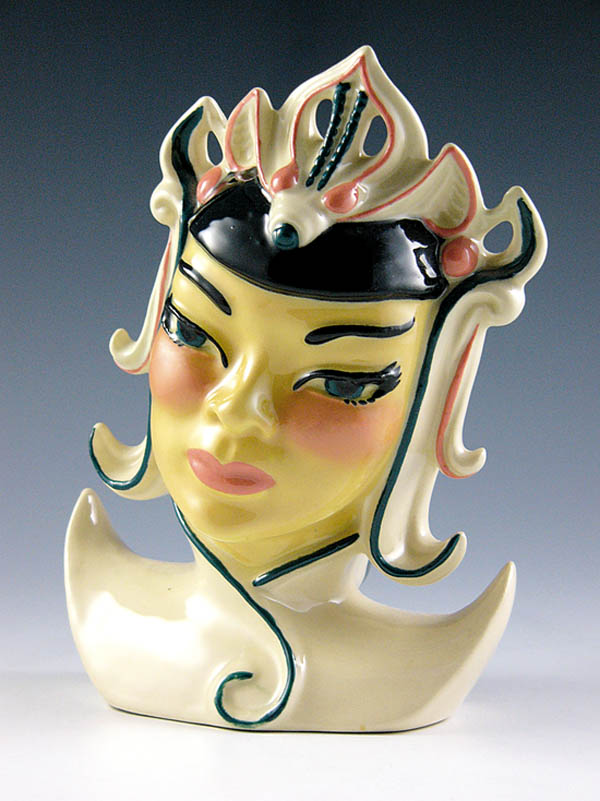What A Wonderful World: Ceramics Go International
Design Trends Of The Mid-20th Century
Nowadays, our response might be, "Eighty days? What took them so long?" But well into the mid-20th century, much of the world remained unexplored territory for most of the world's population. You "grew where you were planted." Curiosity, however, ran rampant. Those folks from elsewhere: what did they look like? Dress like? What did we all have in common? For giftware designers of the 1940s and '50s, engaged in an ongoing quest to fill store shelves, providing the answers opened up a world of possibilities.
Nearly every U.S. ceramic firm of note (and many not-of-note) included at least one representative of another culture in its product line. Some offered enough nationality options to populate an entire United Nations. Prior to WWII, inexpensive ceramics from Europe and Asia had dominated giftware sales in the states. With the onset of the war, many of those production outlets were closed for export. If America wanted knickknacks, then America would have to produce its own. With clay being one of the few raw elements not affected by rationing restrictions, a multitude of domestic ceramic firms sprang up, opening paths for many previously-untested designers. Among the notables were the following.
Ceramic Arts Studio
Madison, Wisconsin's "little studio that could" boasted an entire "Foreign Costume Series" of over 100 different figurines designed by Betty Harrington. A stickler for accuracy, Harrington kept a detailed scrapbook filled with costume reference illustrations and her own sketches.
Hedi Schoop
The Schoop studio covered all the bases when it came to secondary uses for international figurines. Among them: flower-holders, planters, wall pockets, candlesticks, bowls, ashtrays, candy servers, and even soap dishes. Many Schoop figurines reflected the idyllic rural themes of her own Swiss heritage.
Florence Ceramics
Florence Ward's delicately detailed figurines are noted for their elaborate costuming. French and Chinese characterizations were favored subjects. Regardless of country of origin, the facial features of Florence figurines remain remarkably similar (and are much like those of the artist herself).
Joy Thompson
Produced in limited quantities, each hand-decorated Thompson ceramic is literally "one-of-a-kind." Languid and long-limbed, Thompson's vine-draped, flower-bedecked figurines are quite deliberately of non-specific Asian or mythic European heritage.
Copa de Oro
The work of ceramist Mary Jane Hart, these fanciful figurines of terra cotta or white clay are noted for their gold ornamentation, and applied handmade flowers. Costly even in their day, Hart's international figures, like Joy Thompson's, are indeterminately Asian.
Will-George
Famed for their flamingos, the three Climes brothers who comprised this partnership proved equally adept at figural design. Often their figurines were part of a console set: a narrow bowl "boat" for example, accompanied by Chinese oarsmen, a seated maiden, and bamboo-leaf candleholders.
Walter Wilson/McCarty Brothers
Although many exquisite international figurines bear the mark "Walter Wilson" he may actually have only manufactured and distributed the designs of others. In the early 1940s, Wilson distributed ethnic figurines by the McCarty Brothers, Lee and Willard. The McCartys later successfully struck out on their own, but their work remained much the same.
Ceramic designers of the 1940s and '50s fashioned figurines that ran the global gamut. Thanks to their creative ingenuity, the buying public of the time received a no-limits passport; they could explore the world without ever leaving home. Today, we can encircle the globe in far less time than Jules Verne's 80 days, but the thrill remains. Ceramics of this wide and wonderful world send us on a journey to parts unknown ... a journey that continues to beckon and enthrall.
Photo Associate: Hank Kuhlmann.
Donald-Brian Johnson is the co-author of numerous books on design and collectibles, including "Postwar Pop" a collection of his columns, and an upcoming second volume. Please address inquiries to: donaldbrian@msn.com.

Donald-Brian Johnson
Donald-Brian Johnson is a nationwide columnist, and the co-author of numerous Schiffer books on design and collectibles. His most recent, "Postwar Pop," is a collection of his columns.














